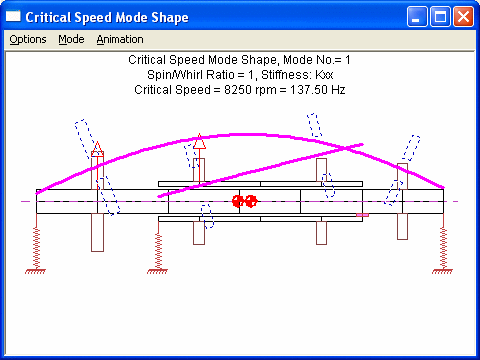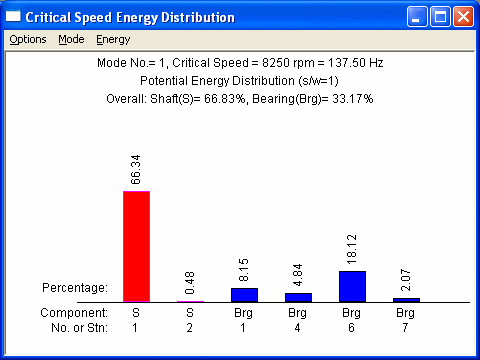
Critical Speed Mode Shape and Energy Distribution
This plot displays a 2-D undamped critical speed mode shape. The graphic Settings under Options menu are self-explanatory, try them yourself to see their effects. The Mode menu allows you to switch the mode number quickly without entering the Setting dialog. Animation option allows you to animate the motion.
Mode Shape

Energy Distribution

Modal Stress

The above figure shows the forward synchronous critical speed mode shape of a two spool dual rotor at 8250 rpm. The bearing stiffnesses Kxx was selected in the run time data. The mode shape is relative displacement and normalized eigenvector which does not have dimension. The kinetic energy is divided into translational and rotational energies. The translational kinetic energy is generated by the mass, and the rotational kinetic energy is generated by the combination of the rotating inertia energy and the gyroscopic energy. Note that the rotational energy is negative for this forward synchronous mode. The negative effect is caused by the gyroscopic energy which causes an increase in the forward synchronous critical speed. For the forward precessional modes, the gyroscopic effect contributes negative kinetic energy and tends to raise the corresponding forward whirl frequency. For the backward precessional modes, the gyroscopic effect contributes positive kinetic energy and tends to lower the corresponding backward whirl frequency. The gyroscopic effect can be significant in the study of high speed overhung rotor system where a large wheel is mounted outside the bearing span.
There is no potential or strain energy in the disks. This is because the disks are assumed as rigid. There is no kinetic energy in the bearings. This is because the bearings are assumed as massless. The first shaft has a strain energy of bending of 66.34% and the second shaft has a strain energy of 0.48%. This indicates that the bending occurs in the first shaft and the second shaft is essentially rigid. This result can also be observed from the stress output.
See also Lateral Vibration Analysis, Critical Speed Analysis.
Copyright © 2014-2017